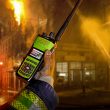Exploring LMR subsystems
Exploring LMR subsystems
A version of this article appeared in the February 2013 print issue with the headline: A lot to consider.
All communications systems have specifications. Some involve dimensions that are easily seen or measured. Others require specialized equipment to measure or confirm. Regardless, if a component fails to meet the design engineer's exact specification, the system will not perform properly.
Sometimes, the exact piece of equipment cannot be obtained, and substitutions must be made. When this occurs, the design engineer must determine whether the substitution will work, and the specifications will be the deciding factor, in most cases.
Communications systems consist of thousands of separate items, some of which are so subtle that they are easily overlooked. The difficulty is that, if the wrong pieces of equipment are designed or put into a system, it will not perform properly and resources will be seriously affected.
In this article, we examine some key subsystems that may not get enough attention from engineers when specifying a system.
Control Systems
These let the console operator control the transmitter and receiver. They vary from very simple to quite complex, as follows.
- Local — This occurs when the push-to-talk microphone and speaker are within reach of the operator and no additional equipment is needed to operate the radio.
- DC remote — This occurs when the control console generates DC current. The base-station radio then senses the polarity and current level, letting users remotely transmit, monitor a channel, change a channel, or change other base-station functions. A DC-continuity pair of wire must be connected between the console and the radio.
- Tone remote — A series of tones are generated between the control console and the base-station radio that lets the user remotely transmit, monitor a channel, change a channel, or change other base-station functions. A two- or four-wire audio connection is needed between the control console and the radio.
- IP remote — Connectivity between the remote base station and the console is achieved via an IP network. This can be accomplished with a wired LAN, a wireless LAN, a wide-area network, or even the Internet.
Voting Systems
Used in urban, suburban, and rural areas, voting systems leverage multiple receivers operating at different locations on a single frequency to extend the range of a system and provide good coverage throughout the footprint.
Voting systems have been available for more than 50 years and are quite sophisticated today. The key is to ensure that users cannot detect any difference in the field unit's audio as the voter continually selects the best signal for a given transmission as the field unit moves between different receivers, via the following approaches:
- Signal-to-noise — This type of voter uses the ratio between the transmitted audio and the noise floor of the signal to determine the best audio for dispatch and field units. The current state of the art lets system technicians and engineers pick the exact frequency band that is considered noise and the one that is considered voice.
- RSSI — Received signal strength indicator (RSSI) is a level expressed in decibels referenced to 1 mW, or 0 dBm. It tells the central voter how well each receiver is receiving the signal, so the voter can select the receiver with the best signal level to ensure optimal audio.
- VoIP — In a voice-over-Internet Protocol (VoIP) system, both the RSSI and signal-to-noise ratio are factored into the voting process, and the best signal is presented to the users.
- Digital systems — RSSI typically is used to select the best receiver.
Grounding
Grounding is essential to avoiding damage at a radio site during a thunderstorm. By following accepted engineering practices, sites are much more likely to withstand the effects of lightning.
A primary lightning strike is easy to spot, as it will vaporize the antenna and melt the metal coax, sometimes resulting in serious fires. Consider the following to lessen the impact of secondary or tertiary lightning strikes:
- Tower — A good foundation is key, and each leg must be connected with AWG #2 gauge wire or larger. This wire must be welded to the legs, because lightning strikes will destroy normal clamps and lugs.
- Transmission lines — Each transmission line on the tower must have a ground kit on the shield of that line at the top antenna end, at the bottom of the run — just before the line leaves the tower — and just before the line enters the transmitter building. If the line is longer than 100 feet, then a ground kit should be attached to the coax every 100 feet.
- Lightning protection — A lightning protector should be in series with each transmission line coming into the radio site. The protector should be grounded and must have the same frequency range as the equipment it is protecting. Also, the output power of the transmitter — the aggregate power level in combined systems — must not exceed the power rating of the protector.
- Bonding — This occurs when all metal items at the site — fences, cabinets, desks, equipment racks, door frames, metal doors, air conditioning units, and all of the radio equipment and racks — are connected by wire that is at least AWG #6 gauge. With everything having the same voltage potential during a lightning strike, the possibility of damage and fire are reduced.
- Measurement — The effectiveness of a ground can be measured with a ground test set, which is different than a normal ohmmeter. If your site is damaged regularly by lightning, then someone should go measure ground resistivity at the site with one of these test sets.
Simulcast
Simulcast systems have two or more transmitters that send the same message at the same time. With today's simulcast technology, it is impossible to discern between an area covered by a single transmitter and an overlap area covered by multiple transmitters. The key to making simulcast work is to ensure that the frequency, modulation and audio processing are identical for all transmitters.
Using GPS time-base control ensures that all transmitters are on the same frequency. If storm clouds block the GPS signal, the internal time base must provide a frequency reference that is as close as possible to the GPS reference frequency.
When there is a CTCSS or DCS signal on the radio channel, it also must be synchronized. This can be accomplished by using a master oscillator and delivering the same coded squelch to all transmitters from the same source. Alternately, it can be accomplished by using a GPS-synchronized tone or digital squelch.
When transmitters are at varying distances from the originating site, the closer units must have their audio delayed, so all transmitters send the same message at the exact same time. If a radio link is involved, the signal delay is 5.37 microseconds per mile. When repeaters or microwave systems are involved, there is a finite amount of time that it takes to propagate through the equipment.
Time-delay interference occurs when a distant transmitter sends out a signal over too far a distance. The proper use of lower-gain antennas, antenna downtilt, lower power, and propagation planning helps lessen this problem.











